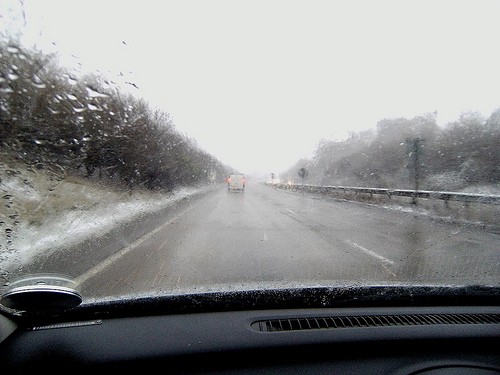Last Updated on October 12, 2024 by
How to drive in snow – Many travelers will take to the highways and interstates this holiday season, facing snow, ice, and other winter conditions.
Our family will be driving long-distance for a ski vacation in Canada, and we want to make sure we’re prepared for safe winter driving.
Raised in the Tahoe, CA area known for heavy snow fall, I like to think I have a few tips for how to drive in snow and ice.
How to drive in snow and ice
Everyone on the road can arrive safely with these winter driving safety tips.
Check road conditions before you go
Yes, you can find road closure information on the car radio en route, but it’s much better to know what you’ll be getting into ahead of time.
Bookmark highway and weather condition websites before you leave, for easy access on your smartphone.
The Department of Transportation will list the appropriate sites for the states you’ll be traveling through.
Have emergency tools and provisions in your car
It’s not a fun use of your money, especially since — hopefully — you won’t ever need to use all of the emergency provisions, but having the right equipment in your car is necessary.
Not only will you be safer with the appropriate chains or snow tires on your car for winter travel, but having them can save your vacation:
I’ve seen cars turned away at interstate check-points for failing to have the right chains.
In addition to chains or snow tires (sometimes unnecessary if you have four-wheel drive, but always a good back-up), pad your luggage with extra blankets to have at the ready, and be sure to have at least one cooler of bottled water and snacks.
And remember to have always have complete first-aid kit as well.
During my years working as a Search and Rescue volunteer, we’d spend nights patrolling road closure areas, handing out food to stranded cars.
Remember, public service volunteers can’t be everywhere at once.

Photo credit: M. Pettitt.
Be wary of alternative GPS routes
We all have learned to rely on our navigation systems, but be cautious of taking alternative ‘shorter’ routes during the winter.
Our GPS unit has advised us to take forest service roads instead of well-traveled highways as a shortcut to our destination, but such choices can prove hazardous, or even deadly.
Before taking a new route, stop for a bite to eat or a tank of gas and ask a local if it’s a good idea.
Slick roads can turn to icy roads after sundown or as temperatures drop
Always decrease speed over bridges or overpasses, as these section of road can be icier, and as the sun goes down, remember that roads that were wet just hours or even minutes before may now be icy.
It’s also important to make sure you can see properly in fog or darkness.
Consider running your air conditioner to bring fresh air into the car (many will do so automatically on the ‘defrost’ setting).
And remember it is difficult to impossible to always see black ice.
Depending on where in the country you live or are traveling to, be aware of this condition.
Avoid over-steering if you lose traction on icy roads
We’ve all heard this advice, but it’s surprisingly difficult to execute mid-skid; our instincts often tell us to continue turning the wheel.
In fact, doing so can put yourself, your car and passengers at greater risk, as you may dart in that direction if your tires regain traction.
Use your anti-lock breaks to their potential, stomping once and keeping the wheel as steady as possible.
When I lived in Bellingham, WA and black ice was prevalent a week or two out of the year, I would prep myself by silently repeating, “hold the wheel,” down my hilly street when I made the turn out of my neighborhood.
I skidded many times but did my best to stay calm.
Best winter driving safety tips
With planning and mental preparedness before you get behind the wheel, you will do much better when driving in less than ideal conditions.
Remember to know in advance an idea of the directions to your destination — how long will you be in the car and how many miles are you going before having to turn — and eliminate distractions by turning off the volume on your mobile phone and turning off the radio.
If you are traveling far for a vacation or holiday getaway, sometimes it’s worth comparing the pros and cons of driving versus flying.
There’s lots of sound advice on how to drive in snow and ice so it’s important to prepare before departing on to winter roads.
The Department of Transportation also has great tips for staying safe on the road.
Fun snow activities to get you outside to Make You Appreciate the Snow
When it’s 20 degrees Fahrenheit outside, it is very tempting to hole up inside and wait for spring.
But one of the best ways to get through a tough winter is to get outside and enjoy it.
Here are some fun snow activities to get you off the couch and into the great outdoors.
Many of these can be done even as you get older.
Fun times in the snow is not just for kids!
How many of these have you tried?
Cross-Country Skiing
If you enjoy downhill skiing, but live somewhere without mountains, give cross-country skiing a go.
You might be able to ski right on your street, in a nearby park, or on a trail.
Rent the equipment to see if this is something you might enjoy before buying new skis.
Go with a buddy at first, and unless you are in great shape, start slow.
Best to get the hang of it so you can enjoy it the entire season instead of doing too much the first day and straining yourself.
Skijoring
Ever heard of skijoring?
If your dog is going stir crazy this winter, this combination of skiing and dog sledding is the activity for you.
Depending on the breed of dog — active dogs, including Setters and Pointers — and northern breeds, including Malamutes and Huskies — may well enjoy this person-dog activity.
Your gear includes your cross country skis and poles and a skijoring harness and your dog or dogs need to be equipped with a harness for a sled dog.
Investing in an UltraPaws Skijor Package will get you started.
Ice skating
Ice skating is like riding a bike — even if it’s been a few years since you skated, once you are on the rink, you will remember how it’s done.
Many park districts offer skate rentals so you don’t have to make an upfront investment unless it’s something you know you will want to do a few times a season.
However, if you can find a pair at a garage sale or thrift shop in your size, buy them.
They will pay for themselves, and they don’t take up that much room — like ski equipment does — to store.
Downhill Skiing and Snowboarding
Skiing and snowboarding are great ways to take advantage of the cold weather and beat the winter blues.
You can rent all of the equipment you need, from skis and snowboards to boots and helmets, right onsite.
If you are just starting out, it may well be worth the time and money to take some lessons before you begin.
If you aren’t new to the sport but it’s been awhile since you have been skiing or snowboarding, take a group lesson.
It’s a great refresher to get you back into the groove.
Plan for a ski vacation and have something to look forward to.
Broomball
Hockey meets soccer in this sport, which is played on an ice rink.
Start your own league or look for one in your community.
This can be fun to play with people in your neighborhood and is fun for kids and adults alike.
Broomball equipment has evolved over the years.
People used to play broomball with actual corn brooms.
If you end up on a league, you will need special rubber-soled shoes to play.
What’s fun about this is that you can improvise with the equipment and even play in the yard, not on ice.
Playing with brooms from the dollar store can be a novel and cheap way to play.
Sledding
Nothing beats the feeling of racing down a hill on a sled.
Scope out sledding hills in the summer and fall.
Find ones free of trees and other obstacles.
Even adults can have a difficult time navigating a sled when the ground is frozen, so always use caution.
Depending on where you live, you may be able to have some impromptu sledding moments on your very own driveway or street.
Watch out for moving cars and never sled down a street with parked cars.
Snow Tubing
Snow tubing is similar to sledding, but all you need is an inner tube and a hill to enjoy this winter activity.
You can buy the snow tubes and do this at a nearby hill.
In some areas, there are snow tubing companies where you can rent, use and return them.
Tow ropes make it a lot easier too!
Ice Hockey
Hockey requires a bit more planning and equipment than some other winter sports, but it can be a fun way to while away the winter.
Before you start playing, you’ll want to make sure your skates fit right, and that you are using the right size stick by using this hockey stick length chart as a reference.
There are children and adult leagues available.
Snowball Fight
Channel your inner child and organize an inter-generational snowball fight in your neighborhood.
Have the kids build snow forts to ward off attacks from the adults.
Explain the rules of not hitting people in their faces and no throwing ice.
Other fun snow activities for winter
Looking for more cool things to do in the snow?
Play kickball, dodge ball or wiffle ball!
Build snow forts or build a hill of snow in the backyard.
Anything to get you moving and enjoying the bright snow is sure to be fun.
In some parts of the country, winter lasts a long time, so you might as well get outside and enjoy it!
These activities to do in the snow will make it go faster so make a point of trying a few of these fun snow activities and look forward to the winter season.
Related Content: Vacation Planning Top 5 Tips, Things To Consider While Planning!
